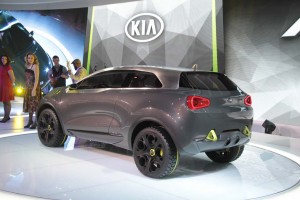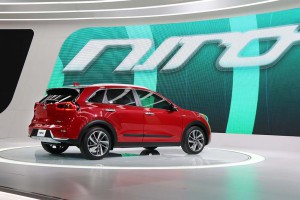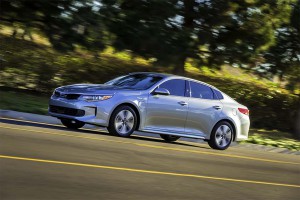What would Toyota do if it were starting from scratch, designing the Prius today? Would the world’s best-selling hybrid still have a relatively conventional five-door layout? Or might it follow current fashion?
That was the question Kia’s product development team apparently had to answer when they began working up their own dedicated hybrid-electric model. And in their case, they opted for a slick subcompact crossover-utility vehicle dubbed the Kia Niro.
First shown in concept form more than two years ago, the production Niro loses such fanciful touches as the scissor-style doors. But Kia didn’t take the easy out, simply stuffing a gas-electric driveline in an existing CUV model like the Sportage. Instead, the Korean carmaker opted for a ground-up development program designed, it claims, to strikes a balance between styling, utility, fuel-economy and that elusive fun-to-drive factor.
“The Niro hits the sweet spot by offering the best combination of outstanding mpg, an engaging driving experience, utility, and most importantly, a stunning design that doesn’t shout ‘hybrid,’” claimed Orth Hedrick, vice president product planning KMA, prior to the new hybrid’s debut at the 2016 Chicago Auto Show.
(Kia planning to add first sports sedan. Click Here for more.)
The 2017 Kia Niro isn’t the Korean maker’s first battery-based model. It first introduced the Optima Hybrid and the Soul EV. And it will bring not only a new hybrid version of the latest Optima to Chicago, but also the brand’s first plug-in, the Optima PHEV. By 2020, Kia promises to triple the number of battery-based models it offers.
But Niro starts out with its own, unique platform and body, a combination that allowed designers and engineers optimize its development. The basic architecture, or chassis, consists of 53% advanced steel that is both lightweight and strong, something that improves mileage without compromising safety, Kia claims.
Lightweighting was a key target, with the product team focusing on everything from the seat frames to brake calipers. They even traded in the traditional 12-volt lead-acid battery for a lighter lithium-ion polymer battery.
(Click Here for more on the new Kia Sportage.)
The exterior design adopts familiar Kia cues, such as the tiger nose grille. The overall shape is a bit lower and wider than many subcompact utes, giving it a bit more of an athletic stance. More traditional details include muscular shoulders, rocker cladding, roof rails and a rear skid plate.
With a 106.3-inch wheelbase and the more upright seating of a utility vehicle, the interior looks less cramped than the Kia Niro’s exterior footprint might suggest. It also helps to have the main lithium-ion powerpack tucked under the floor, rather than gobbling up space in the cargo or passenger compartments.
The interior is a relatively uncluttered affair, with glossy black and white accents giving something of a high-tech feel. The seats give a good view of the road and feature extra padding to reduce fatigue on long drives.
Kia claims it also put an emphasis on reducing the traditional buzzes and whines experienced with many other hybrid-electric models. Among other things, it added special foam and padding under both the floor and the hood.
And that’s where the heart of the 2017 Kia Niro can be found. The drivetrain starts with a new 1.6-liter direct-injected gasoline engine designed specifically for hybrid applications. It makes 103 horsepower while improving efficiency by using the Atkinson Cycle. An exhaust heat recovery system helps further reduce fuel consumption, Kia explains, by quickly warming up the engine.
A transmission-mounted electric motor kicks in another 43 horsepower, the combined hybrid driveline generating 146 hp and 195 pound-feet of torque through the front wheels. The motor draws power from that 1.56-kilowatt lithium-ion polymer battery mounted under the floor.
Kia says it put plenty of engineering emphasis on the blended brake system to give it a more natural feel – an issue many hybrid owners often complain about with earlier models.
While final numbers haven’t been determined, Kia says it is targeting an EPA combined rating of 50 miles per gallon, only slightly less than the recently redesigned Toyota Prius.
The 2017 Kia Niro will offer a wide range of optional safety features, including Blind Spot Detection, Rear Cross-Traffic Alert, Active Cruise Control, Lane Departure Warning and Forward Collision Warning with Autonomous Emergency Braking.
Infotainment features include Apple CarPlay and Android Auto, as well as the extensive telematics services of Kia’s own UVO eServices system. They can be operated on a 7-inch touchscreen display.
Niro also introduces a new technology, dubbed Predictive Energy Control, that uses the car’s navigation system to adjust the operation of its hybrid drive to the terrarin. It’s expected to yield as much as a 3% improvement in fuel economy.
The 2017 Kia Niro will come tomarket at a challenging time. With fuel prices lower than they have been in nearly a decade, demand for battery-based models, even the vaunted Toyota Prius, slipped last year. But demand for small crossovers grew at a record pace. Kia is clearly hoping it can pitch Niro as delivering the best of both worlds: the fuel efficiency of a hybrid but the styling and other attributes that have made the CUV market sizzling hot.
Kia plans to follow up with a more advanced plug-in version of the Niro about a year after its U.S. debut in the fourth quarter of 2016, according to vice president Michael Sprague.
(SUV sales continue to accelerate. Click Here for the story.)




